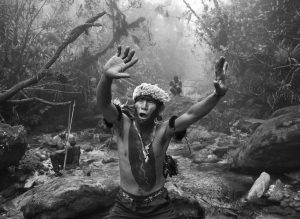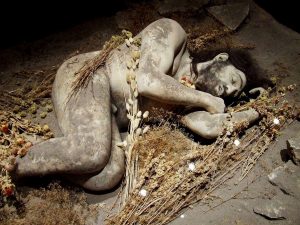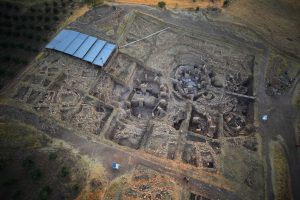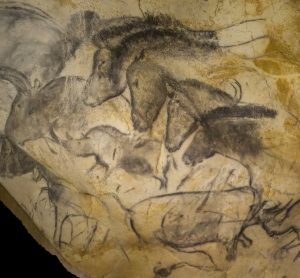11 Making Meaning: Religion, Magic, Art
Phil Geib
Learning Objectives
- Learn about the universality of seeking meaning in the world: explanations for mysteries about the natural world and of life, death, and the great beyond.
- Appreciate how all accounts are human inventions that involve our inventive mind and a tendency to find and interpret patterns, even random ones.
- Appreciate the diverse array supernatural entities that societies believe in and the roles of religious practitioners.
- Evaluate reasons for why humans hold supernatural beliefs.
- Consider what functions such belief holds in society.
- Ponder the intersection of supernatural belief & art.

All humans invent ways to understand the world, especially for aspects of life that lie beyond the limits of our knowledge or that seem beyond our control. You know, the BIG questions:
- Why am I alive?
- What is the origin of the world?
- What happens when I die?
Our invented ways of understanding the world can provide some sense of comfort or at least an explanation for the unknowable. It is also one of the most important outlets for and drivers of human creativity.

Yetis are the Tibetan or Himalayan version of Big Foot: a hairy humanoid primate that walks on two legs. Yetis reputedly live on the Tibetan Plateau. An academic journal called Proceedings of the Royal Society B published a report in 2014 on a DNA analysis of hair samples supposedly from yeti’s. This was followed by additional DNA analysis in 2017 that included a leg bone and feces along with hair.
Samples like this are excellent because they move the argument from anecdotal accounts that are not readily refuted into the realm of science where physical evidence can be tested with proven methods. The analyzed supposed yeti samples are the best physical evidence available–not some hazy recollections or poor quality images that are hopelessly ambiguous but materials that allow for rigorous hypothesis testing. And some of these these samples were collected by people shortly after having supposedly seen one of the mythic critters. They are samples put forward by the faithful!
What do you think that the results might be? Yes or No? Did the DNA tests proved that Yeti’s are real?
DNA revealed that none belong to a Yeti. Most of the samples came from bears, animals who are well known for standing upright on occasion on their hind legs. One hair sample is from a dog; they also on occasion stand on their hind legs. The best physical evidence for the existence of the Yeti or Bigfoot comes from animals that we already know to exist. There simply is not any physical evidence for these mythic creators.
Do you believe in these DNA results? Yes or No? What do you think?
You should also ask yourself this question: If you were wrongly convicted of a crime and DNA could exonerate you, would you trust the veracity of the technique then? Facts are stubborn things. Choosing to believe in them only when they suite your preconceived notion is FOLLY
“What possible relevance does this have?” you might well be wondering for a chapter on Making Meaning. The relevance of this is twofold: First, what you believe to be true about the world can influence your perception of that world. If you believe in Yetis, then a mundane bear can become something else. It can become something that doesn’t even exist. Beliefs, even absurd beliefs, can supersede facts. Secondly, faith in beliefs that ostensibly make sense of the world is often unshakable, impervious even in the face of facts. Yeti believers have already issued a statement condemning the scientific study as flawed and proving nothing. Would they also challenge a DNA study that could absolve them of a heinous crime they did not commit?

Faith in beliefs is central to how humans make meaning. Unfortunately, it also opens us up to exploitation. Faith can have serious costs if there is not a realistic assessment of what you put your faith in. Faith can be exploited by others. Televangelists such as Robert Tilton are predatory. They seek donations from distressed people with promises of curing sickness through prayer. Or of helping people of marginal means get out of credit card debt and poverty, by sending him cash through the mail. Tilton has an estimated net worth of 50 million dollars acquired from the faithful, many who live in poverty and poor health. He exploits their faith.
Tilton is just one of a long list of those who are predatory on the faithful: Mike Murdock, Creflo Dollar, Kenneth Copeland, Joel Osteen, James Payne, Todd Coontz, Henery Fernandez, Gloria Copeland, etc, etc. etc.

Sometimes the consequences of faith can be more severe than financial loss. Heaven’s Gate was the largest mass suicide in the US. Marshall Applewhite & Bonnie Nettles led this UFO cult. They met in a mental hospital: she was a nurse, he a patient. Marshall convinced the Heaven’s Gate members to kill themselves so that their souls could be transported to a spaceship that was hiding in the wake of a comet that had passed close to earth. The comet is named Hale-Bopp after its co-discoverers. Sure, that belief system sounds crazy, but it is a reflection of what humans actively do en mass, try to make meaning of the world.
Alan Hale, co-discoverer of the comet, mentioned to an associate before the Heaven’s Gate tragedy his worry about suicides resulting from the comet. “The sad part is that I was really not surprised. Comets are lovely objects, but they don’t have apocalyptic significance. We must use our minds, our reason.”
The Unknown and Unknowable
Imagine you are a human 30,000 years ago who is part of a small group struggling to survive in the world. A violent storm is brewing and suddenly there is a terrific tearing flash of bright light as a lightning bolt descends from the heavens and strikes a tree that part of your group is crouching under. All are dead, including your mother and a sister that had taken refuge there. What is this force that killed part of my family and others in my group? What has happened to the life of these people? How are you to make meaning of this tragic occurrence?
Religion is one why that this occurs. Especially concerning explanations for the unexplainable, the unknown, or the unknowable. We all know what lightning is these days because we have a solid understanding of how it occurs. It is simply static electricity on a massive scale. Really no different than when you rub two objects together, just vastly larger. The consequence of billions of water droplets rubbings past one another and building up positive and negative charges. Even if you don’t fully understand the process, it’s easy to accept the explanation that it is merely part of nature. Not a vast mystery or power wielded by unseen cosmic forces.

Lacking such an explanation we might be more than willing to accept the account that our elders provided that lightning is a force wielded by the hammer of Thor. Or Zeus! Or other named supernatural. Why would you question such possible truths if all other adults in your group accept them and especially if questioning meant risking the wrath of Thor, or Zeus, or whoever. These beings could smote you with a single bolt. That’s power! And you just witnessed the awesome and tragic results of such power.

But even with our modern understanding of the world, questions can arise. The picture captured here is a from a video that shows a double lightning strike to a single car in rush hour traffic. This could have happened anywhere but this happened to be captured on a Russian highway, hence the language of the video. The passengers of the trailing car that witnessed this scene and posted the video seem rather nonplussed about this strike. I would have been holy ssss…! Random chance is why things like this occur, but humans often look to unseen forces at work, causal agents.
Lightning is a ubiquitous force of nature and capable of mass killing. Just one event documented recently in Norway was the killing of 323 reindeer on a ridge from a single lightning strike. Despite the evidence for this die off being a natural occurrence, conspiracy theorists & other cranks argue for nefarious agents: government experiments with chemical weapons or aliens. Sometimes trying to make meaning of the world means forcing reality and facts to fit your vision of the world.
Lightening is just one potentially destructive force of nature and a rather benign one at that compared to tornadoes, earthquakes, volcanoes, hurricanes/typhoons, etc. And some of these other forces have been intensifying in recent years as a direct consequence of our actions, how our burning of fossil fuel has been changing the climate.
Setting aside explanations of the world and cosmos there are still issues that remain unfathomable such as the meaning of life, the spiritual essence of being, and what comes after death.
Universality of Religion
All societies that anthropologists have documented have some beliefs, attitudes and practices relating to supernatural power. As such, all societies have religion; it is a human universal. There is, however, considerable cultural variability in how supernatural power is regarded.
Supernatural entities are thought to have powers that greatly exceed those of mortal humans. Supernatural beings are not subject to the laws of nature and indeed they can be in control of these forces. Supernatural power can consist of gods, forces, spirits, ghosts & demons. Some societies have all in play.
When there are multiple gods, there tends to be a hierarchy with one god that is supreme, as with Zeus for the Greek pantheon. Such hierarchy reflects the society that the religion occurs within. Religious beliefs in general tend to mirror the societies that hold them.
Myths
All societies have stories that recount how various aspects of the world came to be the way they are. The term that anthropologists use for these stories are myths. All societies have myths about the world. Early humans probably had speculations about things they could not explain. The sharing of these speculations became cultural beliefs about the supernatural and about life. Beliefs about where life came from, where humans go when they die, what lightening is, and the like.
Creation myths are just one facet of these. Creation myths are common but not universal. Some societies do not have creation stories. It’s simply not something that needs explanation for some groups. Creation myths number in the hundreds if not thousands. You are perhaps familiar with one of these myths, that in Book of Genesis. All such creation stories are equally probable or improbable, since all provide an account for something that no one was around to witness. They are literally made up stories that get taken on faith.
Myths are important things for anthropologists to study because within them are embedded aspects that the societies value and want to perpetuate. Anthropologists have argued that myths serve as “charters” or “justifications” for present-day social arrangements. The anthropologists Bronislaw Malinowski was one of the first to document how myths contain supposed self-evident truths that serve to explain why a society is organized the way that it is. Among the Trobriand Islanders where Malinowski conducted early research, he found that myths were used to justify social relations and access to land and resources. The same can be demonstrated for myths in western societies that stem from the bible, both our patriarchal tendencies and a belief in dominion over the earth and it creatures. The same can be seen in the Hindu caste system.
Origin of Religion
Religion is a human universal, but when exactly it originated remains unknown. Such beliefs may well date back to at least when fully modern humans can be recognized. Religion is another facet of our culture, part of our inventive and creative human mind. As such, it seems safe to assume that humans invented religion, beliefs about the supernatural, as soon as their mental abilities allowed. This probably occurred very long ago, perhaps more than 200,000 years ago.

It also appears that Neanderthals had some sense of religion since some of their dead seem to have been buried with ceremony. A male burial within Shanidar Cave was thought to have been laid to rest on a bed of flowers. The flowers came from at least eight different species, some of which have known medicinal properties. Additional recent work at this cave confirms intentional burial by Neanderthals of their dead. Some have speculated that the Shanidar Cave burial 4 individual might have been a healer or shaman for the socal group.
Religion involves community, but communities do not require specialized structures to practice religion. Yet, many societies create such structures. The earliest example of religious structures comes from the site of Gobekli Tepe in SE Turkey. Archaeological excavations here have so far uncovered 5 different religious temples on a high hill. Each temple consists of massive circular stone structures. In the center of each are two large T-shaped stone pillars, with the tallest of these towering 16 feet and weigh 7 to 10 tons. Some of the pillars are blank, while others are elaborately carved with foxes, lions, scorpions and vultures. These could be totems of clans who built & used the structures and they likely have a link to animistic beliefs. These temples are dated to between 11 and 12,000 years ago. The sophistication of construction strongly suggests that these were not the first such structures built. Earlier inferior examples might have been dismantled in later building episodes and perhaps the initial religious structures were built with timbers and hence are difficult for archaeologists to detect.

Natural places of distinction can also serve as sacred places for the practice of religion or tied to religious beliefs. High mountains, unusual rock formations, waterfalls, cliff exposures, and the like have held sacred and religious significance to societies around the world. Landscape features are often linked to origin stories or other mythic accounts.

Many societies around the world consider caves to be sacred places, portals to other worlds or settings where you can more readily convene with the supernatural realm. By caves, we mean not the light living caves or rockshelters that people lived in but deep dark caves, those with little or no natural light. It is no stretch to consider the caves like Lascaux where upper Paleolithic people painted images of animals as places of worship, as sacred natural temples. European cave paintings date back to at least 40,000 years ago, so this form of worship is at least that old.
Animism
Animism is the religious belief that objects, places, and creatures all possess a distinct spiritual essence. Many societies around the world had or have animistic beliefs. Animism perceives all things as potentially alive and with a spiritual essence: animals, plants, rocks, rivers, weather systems, human handiwork, even words. Animism is perhaps the oldest known type of belief system.
With animism there are no hard and fast distinctions between the spiritual & physical world
Myths are the stories of how various aspects of the world came to be the way they are. All societies studied by anthropologists have such stories.
A person regarded as having access to, and influence in, the world of good and evil spirits. This term originates from peoples of Siberia but many societies around the world have similar practitioners of divination and healing. It is common for shamans to enter a trance state, sometimes with help of hallucinogens.

